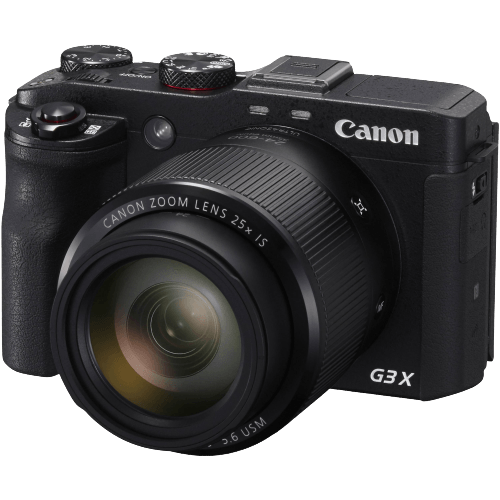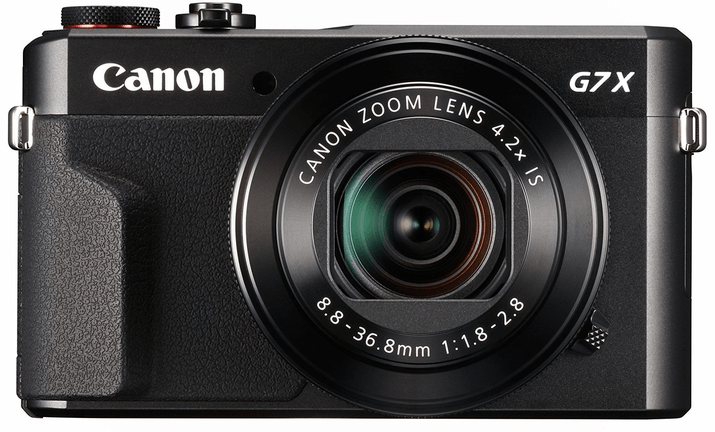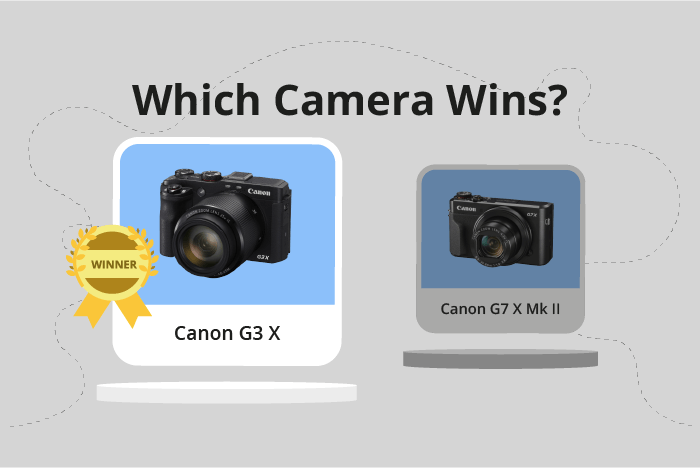Canon PowerShot G3 X vs PowerShot G7 X Mark II Comparison
Canon PowerShot G3 X

Canon PowerShot G7 X Mark II

The Canon PowerShot G3 X takes the lead with a score of 62/100, while the Canon PowerShot G7 X Mark II follows closely with 59/100. Both cameras, announced in 2015 and 2016 respectively, share common specifications such as their launch prices of $999 for the G3 X and $699 for the G7 X Mark II.
The G3 X outperforms the G7 X Mark II with its larger size (123 x 77 x 105mm) and heavier weight (733g), making it a more robust and sturdy option. On the other hand, the G7 X Mark II’s compact size (106 x 61 x 42mm) and lighter weight (319g) make it a more portable and convenient choice for those who prioritize ease of transport.
Considering these factors, the G3 X is a better option for users seeking a more durable camera, while the G7 X Mark II is ideal for those who value portability and convenience.
Canon PowerShot G3 X vs PowerShot G7 X Mark II Overview and Optics
The Canon PowerShot G7 X Mark II wins the optics comparison with a score of 58/100, while the Canon PowerShot G3 X scores 57/100. Both cameras share several specifications: 20 megapixels, a 1″ CMOS sensor, and a fixed lens mount. However, there are notable differences that contribute to their respective scores.
The G7 X Mark II has a superior shooting speed of 8 compared to the G3 X’s 5.9. Additionally, the G7 X Mark II features a more advanced Digic 7 processor, which contributes to its higher DXOMARK sensor score of 79. The faster shooting speed and better sensor performance make the G7 X Mark II a more desirable choice for capturing high-quality images.
On the other hand, the G3 X offers image stabilization, which the G7 X Mark II lacks. This feature helps reduce the effects of camera shake, allowing users to capture sharper images in certain shooting conditions. Despite its lower overall score, the G3 X’s image stabilization gives it an advantage in specific situations.
In the end, the G7 X Mark II outperforms the G3 X in terms of shooting speed and sensor quality, making it the winner in this comparison. However, the G3 X’s image stabilization may appeal to users who prioritize steadiness in their photography. Each camera has its strengths, so the choice ultimately depends on individual preferences and shooting requirements.
Canon PowerShot G3 X vs PowerShot G7 X Mark II Video Performance
The Canon PowerShot G3 X and the Canon PowerShot G7 X Mark II both have a video score of 70/100. This indicates that their video capabilities are on par with each other. Both cameras share common specifications, such as Full HD video resolution, 1920 x 1080 video dimensions, 60fps maximum video frame rate, and built-in time-lapse functionality.
The Canon PowerShot G3 X and the Canon PowerShot G7 X Mark II are evenly matched in these aspects, with neither camera having a clear advantage over the other. Both cameras are capable of capturing high-quality videos with smooth motion and a high level of detail, thanks to their Full HD resolution and 60fps frame rate. Additionally, the built-in time-lapse functionality allows for creative video techniques and effects.
While there are no specific video features where one camera outperforms the other, it is important to consider the overall performance and features of each camera when making a decision. The Canon PowerShot G3 X and the Canon PowerShot G7 X Mark II both have their own strengths and weaknesses in other areas, such as image quality, autofocus, and ergonomics. These factors may influence your decision when choosing between these two cameras.
In comparing the video capabilities of the Canon PowerShot G3 X and the Canon PowerShot G7 X Mark II, it is evident that both cameras provide similar video performance. As a result, your decision should be based on other factors, such as image quality, autofocus performance, and ergonomics, to determine which camera best suits your needs.
Canon PowerShot G3 X vs PowerShot G7 X Mark II Features and Benefits
The Canon PowerShot G3 X outperforms the Canon PowerShot G7 X Mark II in terms of features, scoring 87/100 compared to 70/100. Both cameras share several common specifications, including touchscreen capabilities, flip screens, GPS, WIFI, and Bluetooth connectivity.
The G3 X has a larger screen size of 3.2 inches compared to the G7 X Mark II’s 3 inches, providing a better viewing experience. Additionally, the G3 X boasts a higher screen resolution of 1,620,000 dots, as opposed to the G7 X Mark II’s 1,040,000 dots. This results in a crisper and more detailed image display on the G3 X.
Despite the lower feature score, the G7 X Mark II has some advantages. For instance, its smaller screen size and overall compact design make it more portable and convenient for those looking for a lightweight camera option. This can be beneficial for photographers who prioritize mobility over extensive features.
Considering the points mentioned above, the Canon PowerShot G3 X emerges as the superior camera in terms of features. Its larger screen size and higher resolution provide a better user experience, while still offering the same connectivity options as the G7 X Mark II. However, individuals seeking a more compact and portable camera may find the G7 X Mark II to be a better fit for their needs. Ultimately, the choice between these two cameras will depend on the user’s preferences and priorities in terms of features and portability.
Canon PowerShot G3 X vs PowerShot G7 X Mark II Storage and Battery
The Canon PowerShot G7 X Mark II outperforms the Canon PowerShot G3 X in the storage and battery category with a score of 29 against 16. Both cameras share similarities in storage options, including a single memory card slot and compatibility with SD, SDHC, and SDXC (UHS-I) memory cards.
The G7 X Mark II excels with its USB charging capability, making it more convenient for users to charge while on the go. However, the G3 X holds a slight advantage in battery life, offering 300 shots per charge compared to the G7 X Mark II’s 265 shots. This difference may be significant for those who prioritize longer shooting sessions.
Despite the better battery life of the G3 X, the G7 X Mark II’s overall higher score in storage and battery, along with its USB charging feature, makes it the superior choice between the two.
Canon PowerShot G3 X vs PowerShot G7 X Mark II – Our Verdict
Are you still undecided about which camera is right for you? Have a look at these popular comparisons that feature the Canon PowerShot G3 X or the Canon PowerShot G7 X Mark II:

